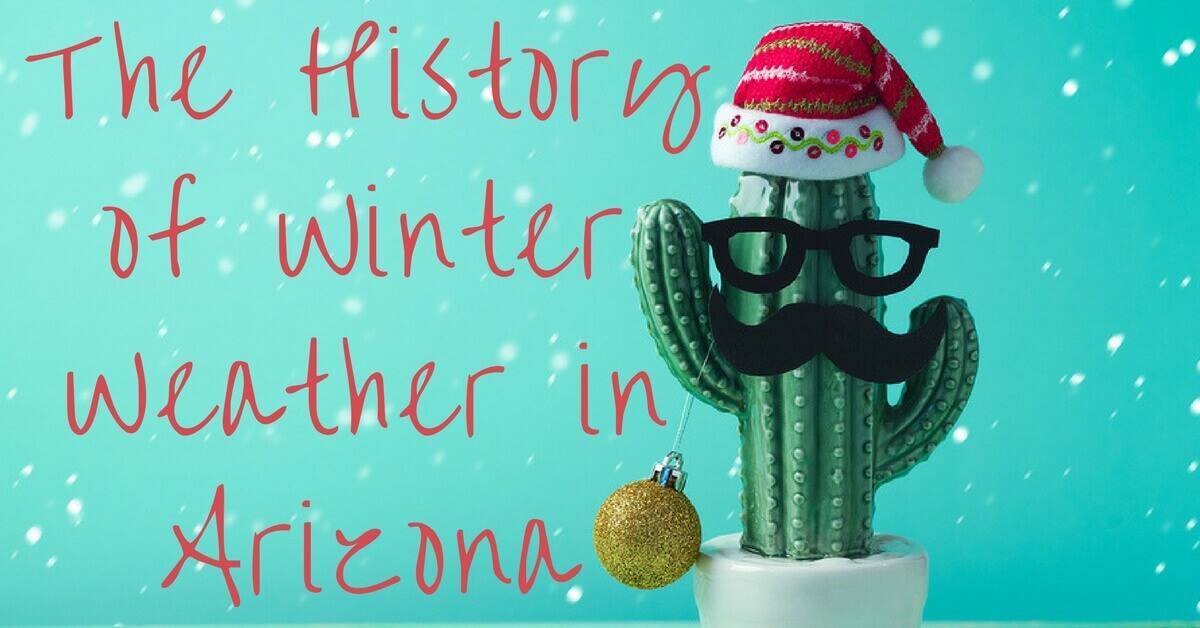- Finding the Right Indoor Plants for Desert Your Home - April 28, 2023
- Common Misunderstanding About Sun Exposure - April 18, 2023
- All about the Arizona Monsoon Season - May 21, 2021
At CC Sunscreens, we are in the business of caring about the weather. In fact, it’s actually our infamous sunshine and severe heat that makes our business and others like us so successful here in the Valley of the Sun. This winter, we’ve decided to switch the focus from the searing heat to the history of our winter weather. What has the weather felt like in December, January and February throughout history? Read through these fun and fascinating facts about our winter weather throughout history.
Winter Storms Throughout Arizona’s History
Believe it or not, we Arizonians have seen some pretty serious winter storms throughout our history. Actually, state forty-eight sees at least some snowfall each winter. Here are some of our most famous storms.
The Great Blizzard of 1967
In 1967, a gigantic blizzard came to Arizona – and didn’t budge. A few days before Christmas a beautiful sprinkling of snow began falling, and residents happily welcomed the prospect of a white Christmas. It didn’t take long for Arizonians to realize that this “lovely” storm was actually an unwelcome blizzard. Within a matter of hours, almost every area of Arizona had received about one foot of snow. Even after the initial dumping of snow, the blizzard kept on. In fact, the storm lasted eight long days and wreaked havoc throughout the state. Greer was the part of Arizona that saw the most snowfall, with a whopping 99 inches (8.25 feet) reported by the National Weather Service. Other areas of Arizona also saw great snowfall such as Hawley Lake with 91 inches and Mount Lemmon with 84 inches. http://www.onlyinyourstate.com/arizona/az-blizzard-1967/
The Snowstorm of 2010
Although the 1967 blizzard remains the worst in Arizona’s recorded history, the 2010 snowstorm will also never be forgotten. In just a few days, the state was pummeled, with Flagstaff receiving about 6 feet in the end. To put this into perspective, Flagstaff normally receives 7-9 feet of snow per year. With so much snow falling in the northern part of the state, the southern parts saw extreme flooding and a state of emergency was called immediately. Many people who lived in rural areas were trapped inside their homes for days. The need was so great that the National Guard actually had to deliver goods via helicopter to many stranded residents. http://www.onlyinyourstate.com/arizona/az-2010-blizzard/
Record Highs and Lows During Arizona’s Winter
Winter Lows
Historically, the coldest month in Arizona is December, with an average low of 44 degrees Fahrenheit. The coldest day ever recorded in the month of December is 22 degrees on December 26th in 1911 and December 31st in the year 1900. For January, the coldest recorded temperature was a bitter 16 degrees on January 7th in 1913. February warms up a bit with the lowest recorded temperature being 24 degrees on February 7th in 1899 and February 8th in 1933. http://www.intellicast.com/Local/History.aspx?month=2
Winter Highs
We all know winters are mild in Arizona, but there have been some extremely high temperatures as well throughout our winters. The highest recorded temperature in December was on December 10th in 1950, coming in at 87 degrees. For January, the highest ever-recorded temperature was on January 19th in 1988, where temperatures reached 88 degrees. In February, things start heating up even more with the highest ever-recorded temperature of a blistering 92 degrees on February 25th in 1921 and February 27th in 1986. http://www.intellicast.com/Local/History.aspx?month=2
Snow Days in Phoenix
The average number of inches of snow per year for US cities is 26 inches. Arizona receives only 0.03 inches of snow each year on average. Phoenix sees snow an average of 0.0 days per year, but it does happen. It doesn’t look likely with the current forecast, but could 2017 be one of those years when coveted snowflakes reach the valley?
How CC Sunscreens Can Help
CC Sunscreens specializes in high quality solar window screens, patio shades and anti-golf ball screens. We work hard to provide Arizona families with protection from harmful UV rays (which are present throughout the year) and the searing Arizona heat. With our solar screens, Arizona homes use less electricity to cool their homes, thus saving money and reducing their carbon footprint. Reach out to CC Sunscreens today to schedule your free, in-home consultation today.

